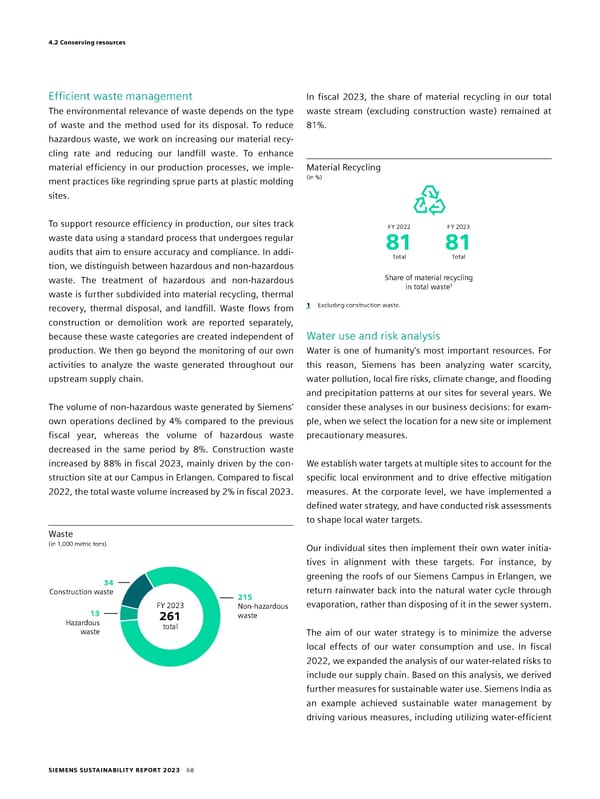4.2 Conserving resources Efficient waste management In fiscal 2023, the share of material recycling in our total The environmental relevance of waste depends on the type waste stream (excluding construction waste) remained at of waste and the method used for its disposal. To reduce 81%. hazardous waste, we work on increasing our material recy- cling rate and reducing our landfill waste. To enhance - Material Recycling material efficiency in our production processes, we imple ment practices like regrinding sprue parts at plastic molding (in %) sites. To support resource efficiency in production, our sites track FY 2022 FY 2023 waste data using a standard process that undergoes regular 81 81 audits that aim to ensure accuracy and compliance. In addi- Total Total tion, we distinguish between hazardous and non-hazardous waste. The treatment of hazardous and non-hazardous Share of material recycling in total waste1 waste is further subdivided into material recycling, thermal recovery, thermal disposal, and landfill. Waste flows from 1 Excluding construction waste. construction or demolition work are reported separately, because these waste categories are created independent of Water use and risk analysis production. We then go beyond the monitoring of our own Water is one of humanity’s most important resources. For activities to analyze the waste generated throughout our this reason, Siemens has been analyzing water scarcity, upstream supply chain. water pollution, local fire risks, climate change, and flooding and precipitation patterns at our sites for several years. We The volume of non-hazardous waste generated by Siemens’ consider these analyses in our business decisions: for exam- own operations declined by 4% compared to the previous ple, when we select the location for a new site or implement fiscal year, whereas the volume of hazardous waste precautionary measures. decreased in the same period by 8%. Construction waste increased by 88% in fiscal 2023, mainly driven by the con- We establish water targets at multiple sites to account for the struction site at our Campus in Erlangen. Compared to fiscal specific local environment and to drive effective mitigation 2022, the total waste volume increased by 2% in fiscal 2023. measures. At the corporate level, we have implemented a defined water strategy, and have conducted risk assessments to shape local water targets. Waste (in 1,000 metric tons) Our individual sites then implement their own water initia- tives in alignment with these targets. For instance, by 34 greening the roofs of our Siemens Campus in Erlangen, we Construction waste 215 return rainwater back into the natural water cycle through FY 2023 Non-hazardous evaporation, rather than disposing of it in the sewer system. 13 261 waste Hazardous total waste The aim of our water strategy is to minimize the adverse local effects of our water consumption and use. In fiscal 2022, we expanded the analysis of our water-related risks to include our supply chain. Based on this analysis, we derived further measures for sustainable water use. Siemens India as an example achieved sustainable water management by driving various measures, including utilizing water-efficient SIEMENS SUSTAINABILITY REPORT 2023 68
 Sustainability Report Page 67 Page 69
Sustainability Report Page 67 Page 69